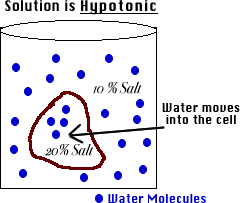
Bacteria reach osmotic equilibrium by two means:
1.In hypertonic environments the volume of the protoplasts will shrink.
2.In hypotonic environments the rigid wall will resist increase in protoplasts volume at a limiting volume of water; equilibrium results from turgor against the wall.
The rigid wall present in the bacteria cells enables most bacteria to tolerate even extremely dilute environments. Osmotic equilibrium is achieved by the development of turgor pressure against the wall. The wall of gram positive micrococci can withstand 22 atm of pressure.
 Although the walls of gram-negative rods have a lower tensile strengths , the walls is sufficiently strong to retain the turgor pressure if the cell is suspended in water.
Although the walls of gram-negative rods have a lower tensile strengths , the walls is sufficiently strong to retain the turgor pressure if the cell is suspended in water.Turgor against a rigid walls is apparently a much simpler development than the mechanism utilized by many protozoa for similar purposes. Protozoa a contractile vacuole to pump out the water in adapting to osmotic pressure in order to maintain equilibrium.
Preservation by High Osmotic Pressure



